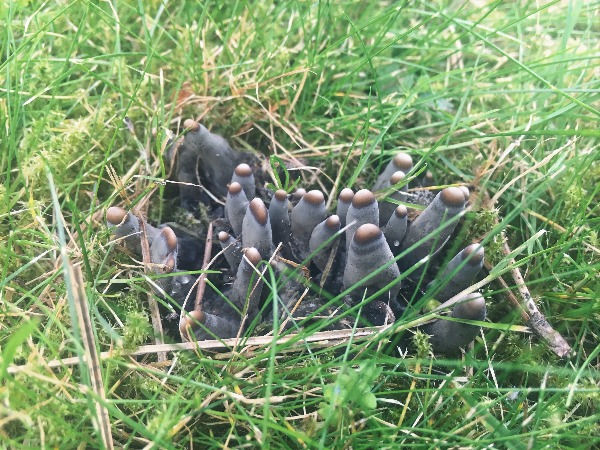Winter warriors: how edible plants thrive in the cold
- The Foraging Course Company
- Jan 7
- 4 min read
While many plants retreat into dormancy or vanish altogether during the chill of winter, a select few emerge as resilient champions of the cold. These hardy survivors not only endure the frost but flourish in it. We explore the adaptations that allow certain plants, including winter edibles, to combat the freeze and continue to thrive against the odds

Winter is a tough time to grow if you are a plant. However, with fewer competitors and leaf munching predators around there are some advantages - as long as you can cope with the harsh temperatures and cell splitting ice. Cold tolerant plants are able to endure and thrive in low-temperature environments thanks to physiological adaptations, safeguarding their cells from frost damage.
One of the main ways of coping for plants that overwinter is by going into dormancy rather than actively growing, as seen in deciduous trees and perennial plants, is by having deep, tough roots and robust, woody aerial parts. However, for most, their more delicate structures - leaves and flowers - are gone by the end of autumn. For the forager, this doesn't offer much in the way of foodstuff, so it is the plants that have evolved to keep those structures despite the weather conditions that are of most interest.

Although the variety of plants with edible leaves, shoots, stems and flowers is limited in winter, the species that do appear are often found in abundance - due, in part, to the lack of competition - and have decent nutritional value. Vitamin C, tocopherols and β-carotene are vital for photosynthesis, as is potassium, iron, magnesium and zinc, amongst others; so if it has got green leaves, it is going to contain these nutrients. Plus, many of them taste pretty good, too.
However, leaves are full of water and this is susceptible to freezing - ice crystals stop or slow nutrient movement and metabolic processes, and can burst cell walls. In addition, frozen ground makes it difficult to take up water for survival - and leaves use and release lots of water. So how is this reduced or prevented?
Ways plants tolerate cold
Structure Some cold tolerant plants develop waxy leaves to reduce evaporation and insulate the cells from frost damage. Another way to reduce water loss is by decreasing the surface area of the leaf - some winter tolerant plants will have long, thin leaves or even needles. Water loss is, of course, also a problem in summer and these structural changes will also help most of these plants to cope with heat stress, too. However, one structural adaptation for cold weather won't help in summer: having small, shallow roots. In winter, this enables the plant to access water from thawing earth quickly. This is a distinct disadvantage in summer when surface water evaporates quickly.
Movement of liquid Freezing liquid is less damaging outside of the cells than it is inside, so some plants move the majority of their cell liquids to those intercellular spaces in cold weather.
Sugars These accumulate in plant cells during cold acclimation. They function as osmoprotectants (balancing osmotic processes) by lowering the freezing point of cellular fluids and stabilising cell membranes and proteins.
Amino acids and acids Another way plants reduce the freezing point of their cells liquids is with amino acids, such as glutamic acid, proline and threonine, and acids, such as salicylic acid. Some of these are also used to aid in the process of moving liquid from inside the cells to the intercellular spaces.
Proteins There are a number of ways proteins can act as cryoprotectants in plants, with different types having their own functions. Examples include: - dehydrins, which stabilise cell structures and prevent proteins denatured (destroyed) during cold-induced dehydration from accumulating - cold regulated proteins, which protect cells membranes and enzymes from damaged caused by freezing - anti-freeze proteins, which prevent ice formation and ice-crystal growth - heat shock proteins, which also function during very cold spells and prevent proteins from denaturing - late embryogenesis abundant proteins, which protect cell structures during freezing - aquaporins, which regulate water movement through the cell membrane and reduce damage caused by cold dehydration - pathogenesis-related proteins, which help maintain structural integrity in cold conditions - superoxide dismutase, which helps mitigate cell damage cause by freezing.

This gives an insight into just a few of the reasons some plants are able to tolerate the cold. Happily for the forager, it mean there are still nutritious greens available to find during the winter months.
These include: primrose (Primula vulgaris), cornsalad/lamb's lettuce (Valerianella locusta), Alexanders (Smyrnium olusatrum), three-cornered leek (Allium triquetrum), wild garlic (Allium ursinum), crow garlic (Allium vineale), common sorrel (Rumex acetosa), hairy bittercress (Cardamine hirsuta) and watercress (Nasturtium officinale).
Not all plants that grow in winter are edible and there are also poisonous species to be aware of as well. However, with a reduced number of plants in leaf, lookalikes are reduce in number making winter a good time of year to start learning about wild edible greens.
Discover more wild edibles and recipes on a foraging course
Always stay safe when foraging. You need to be 100% sure of your identification, 100% sure that your foraged item is edible, and 100% sure that you are not allergic to it (it is good practice to always try a small amount of any new food you are consuming). If in doubt, leave it out!







Comments